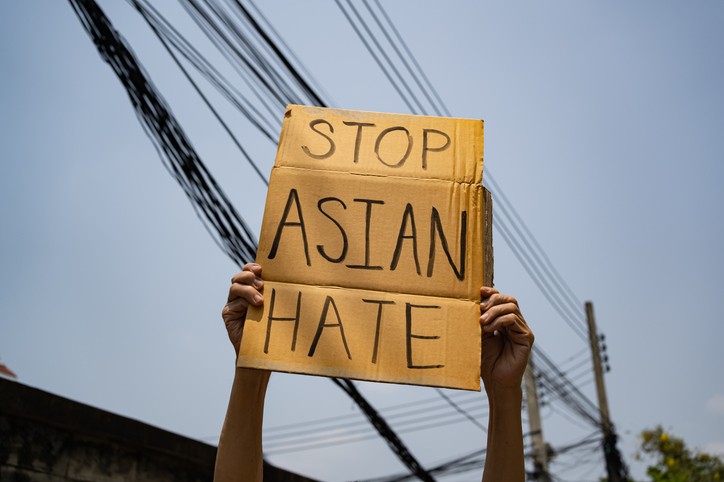May 22, 2023
To Stop Anti-Asian Violence, Invest in Communities, Not Police
Director, Stop Asian Hate Project at the Asian American Legal Defense and Education Fund

This piece is part of a blog series highlighting key legal issues facing Asian American and Pacific Islander communities.
At our office, the calls continue to come in. There was the Chinese woman whose neighbor, a local law enforcement officer, called her a ch*nk and waged an extended campaign of harassment to push her out of the neighborhood. The Vietnamese man who was showered with racial slurs when he confronted a hit-and-run driver about his damaged car. Another woman of Chinese descent who was run over with a shopping cart in the grocery store parking lot. The undocumented woman in public housing who was physically attacked outside her home.
Then, there is the aftermath. The anxiety of waiting for hospital, legal, body shop bills. The disappointment of police inaction. The calculation of whether the logistics and cost of finding a therapist was worth it. The need to move out of harm’s way but no resources to do so.
And there are questions for the broader community. Should I be scared when I leave the house? Will this wave of harassment and violence pass? Is this a hate crime? Or is this “just” another shooting? Does my race make me a victim, like the family killed at the mall in Allen, Texas? Or am I the violence itself, like the gunman in Monterey Park? Will the police target me, like Yia Xiong, the disabled Hmong elder who was killed by an officer, or serve and protect me?
I’m confronted with these questions every day, as a lawyer tasked with responding to anti-Asian violence. In observance of Asian American Pacific Islander Heritage Month, I looked back at our history to explore these questions about harm, identity, and public safety. What I found is that Asian Americans have a lot to learn from the history of other movements and our own.
For some Asian Americans, questions about violence and the criminal legal system are newly salient. For others, it is old news. Like other communities of color, Asian Americans, Pacific Islanders, and Native Hawaiians have been harmed by criminalization. This is especially true in high-poverty Asian neighborhoods, like parts of Long Beach and Stockton, California, that have endured high levels of community violence. Between 1999 and 2004, the AAPI prison population increased by 30%. In 2006, Oakland police arrested Samoan youth at a higher rate than any other racial or ethnic group, followed by Black youth. Cambodian and Vietnamese youth also had high arrest rates. The criminal legal system is particularly harsh to immigrants, who are funneled directly to ICE detention centers after earning their release from prison. Asian massage parlor and sex workers are regularly assaulted, stolen from, and harassed by their clients and the police officers who are charged with keeping them safe. And throughout the Asian community, there is underreported violence at home.
Many Asian community advocates and elected officials have called for strengthened hate crime laws and policing. As they tell it, Asian people are innocent, law-abiding victims who are receiving the brunt of a crime wave and anti-China rhetoric. The reality that Asian Americans can both be harmed, harm others, and be labeled “criminal” is inconvenient to this narrative. People who support law enforcement strategies dismiss reservations about law enforcement as limousine liberalism, even when they are rooted in decidedly Asian American experiences of intracommunity violence, police brutality, and incarceration.
On the other side of the spectrum, even opposition to more policing and incarceration can reinforce a false victim-perpetrator divide. As sociologist Tamara Nopper points out, some calls for Black-Asian solidarity to keep each other safe seem like “Black people are expected to reassure Asian Americans that they don’t ‘hate’ us…while Asian Americans reassure Black people we won’t call for more policing or criminalization of them.” As Nopper puts it, “the reality is all of us can commit harm and violence while only some of us will be prosecuted for crime.”
Increased policing has both easily foreseen and unintended consequences for all of us. One in 20 homicides are committed by police. Police officers kill Black people at a rate 3.5 times higher than white people, but this epidemic has touched all communities, including Asian American ones. The Asian American movement has been shaped by police brutality, like the brutal beating of Peter Yew in 1975 that galvanized the community and established organizing infrastructure that remains active today. In addition to Yia Xiong, earlier this year, Cambridge, Massachusetts police shot and killed a 20-year-old Bangladeshi college student, Sayed Faisal.
Longer criminal sentences—a common feature of hate crime legislation—also seem to have little practical value in making us safer. A 2016 National Institute of Justice review concluded that increased sentencing does not deter crime, and that prisons may in fact exacerbate recidivism. Over a decade ago, federal hate crime laws were expanded to criminalize more offenses targeting LGBTQ+ individuals, yet LGBTQ+ people are still nine times more likely to experience violence due to their sexual orientation.
There is no doubt that targeted violence and hate has overwhelmed our families and communities. But communities under this kind of pressure risk settling for immediate but unproven responses. Advocates for survivors of domestic violence found themselves in a similar position in the 1980s. They successfully advocated for aggressive arrest policies, with 90% of police departments adopting pro-arrest policies by 1991. In 1994, the Violence Against Women Act allocated funding to hire new police officers and prosecutors to protect people from partner violence. But several studies showed that arrests actually increased violence in certain cases. Research also shows that pro-arrest policies increased arrests of men by 60 percent and arrests of women by 400 percent. This is a cautionary tale for anti-Asian violence advocates, especially when police officers and prosecutors themselves have testified that finding clear-cut evidence of hate is difficult, even when they expend investigative resources.
A more effective response to public safety is possible. Justin Go, whose daughter Michelle was killed after being pushed in front of a New York City subway train, has charted a different approach. He proposes an ethic of community care, including preventative measures that fund housing and treatment. There is promising evidence that investments in our built environment, education, health care, treatment, and employment can prevent harm before it happens. These investments have the added benefit of helping people heal and recover after they have been harmed. Expansion of healthcare coverage, for example, both reduces arrests and increases access to medical care and counseling following an act of violence or harassment.
Historically, when advocates seeking protection from violence demand both harsher punishments and community investment, they only get the former. This was true in the domestic violence movement and for Black Americans who never saw the health care, jobs, and investments they asked for when crime and violence was at its highest in the late eighties and nineties. Pushing for the latter will get us the public safety solutions that work, instead of the decades of tough-on-crime policy that cost our communities so much. A public health approach to safety can ensure that people have the shelter, jobs, and care that make them less likely to both harm and be harmed.
_______________________
 Jane Shim is Director of the Stop Asian Hate Project at the Asian American Legal Defense and Education Fund.
Jane Shim is Director of the Stop Asian Hate Project at the Asian American Legal Defense and Education Fund.




